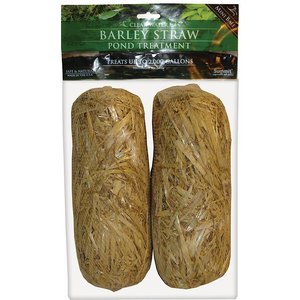How to Keep a Pond Clean Without a Filter (5 Simple Steps)
Pond Academy is reader-supported. Buying through links on our site may earn us an affiliate commission. As an Amazon Associate I earn from qualifying purchases.
Pond filters can save you time from having to do a lot of manual pond cleaning. They work around the clock removing debris and harmful substances, thus keeping your pond clean and clear.
And while we always recommend you use a proper filtration system if you have a heavily stocked pond, you can get away without using one if you follow the right steps.
With that in mind, here’s how to keep a natural pond clean and clear without using a filter!
Do Ponds Need A Filter?
No, most ponds don’t need a filter to maintain good water quality. With that said, filters make it an easy and mostly hands-off process to keep your ponds water quality in tip-top shape.
Whether or not your pond should use a filter will come down to the amount and type of pond fish you have stocked, the size of the pond, and the amount of waste and debris your pond accumulates.
While there’s no hard and fast rule of when you should consider a filtration system, just keep in mind that the more fish you have, the more waste is produced through excrement and wasted fish food. Plus, you must consider the amount of debris your pond accumulates. All of this adds up and would require either more filtration, or more manual work to remove the waste and debris.
And even though there are some steps you can take to help break down the waste that is somewhat hands-off, which we’ll get to below, you’ll still be doing considerably more manual removal than if you were to use a filter.
So, if you’re ready to go for it, let’s look at how to keep your pond clean without a filtration system. If you've decided maybe you should use a pond filter, then check out our pond filter reviews to find the best filter for your specific pond or water garden.
Get Our Best Pond Tips Sent to Your Inbox for Free!
Join thousands of others and learn from our decades of pond building and maintenance experience! Your pond will thank you!
By subscribing you agree to receive emails from PondAcademy.com. We will always respect your privacy and you can unsubscribe at any time.
How To Keep Pond Water Clear Without A Filter
The steps below will help you maintain clean and clear water whether you use a filter or not. In fact, even in ponds with filters I recommend most of these be performed. However, in ponds without filters, you may have to perform some of the steps more often.
So, here’s how to keep pond water clear naturally and without using a filter.
1. Natural Pond Filter Plants
Pond plants are one of the best ways to naturally filter your pond! They absorb excess nutrients, help oxygenate the water, and can remove any harmful substances in your pond or water garden.
Algae and weeds need nutrients to grow and thrive. And pond plants help consume those excess nutrients so algae and pond weeds can’t get out of control.
The oxygen provided by pond plants will not only help your fish survive and thrive, it helps beneficial bacteria as well, which in turn breaks down waste.
Floating pond plants can provide cover for your fish as well as block sunlight from reaching the water which is a contributor to algae growth.
Be sure to fill your pond with a mix of floating, emergent, and submerged oxygenating pond plants for best results.
Benefits of Pond Plants
- Provide oxygen to your pond's water
- Consumes excess nutrients
- Helps control algae
- Protects fish
- Blocks sunlight
2. Pond Aeration
Pond aeration not only provides vital oxygen to your fish, but it can also help keep your pond clean and clear without relying on a filter!
It does this by improving the levels of beneficial bacteria in your pond (they need lots of oxygen to survive) which will help break down waste in your pond and reduce the amount of pond muck.
As a side benefit, a pond aerator will help provide movement to the surface of your pond, which effectively stops mosquitos from breeding in your pond and prevents algae from overtaking the surface.
Check out our reviews of the best pond aerators on the market today to find the right aeration system for your pond.
Benefits of Pond Aeration
- Provides vital oxygen to the pond
- Improves beneficial bacteria levels
- Creates surface movement
- Repels mosquitos
3. Debris Removal
Since we’re not using a pond filter, we’ll need to remove any debris and muck that has accumulated in our pond by another means.
And we’re talking about any floating debris and the debris that has already sunk to the bottom and inevitably turned into sludge.
A little sludge on the bottom of your pond isn’t a big issue (and can even provide nutrients for beneficial bacteria and plants), however, it needs to be kept in check. Too much sludge will essentially lower the oxygen in your pond and create water clarity issues.
The easiest way to remove pond sludge and debris is to suck it up with a pond vacuum. Pond vacuums make this task easy work, especially if you have a larger pond.
A more manual way is to use a telescoping pond net or pond rake to remove debris. A pond net can be used to remove debris and even scoop sludge off the floor of your pond.
A pond rake, while excellent for removing debris and weeds, might not be the best option to remove sludge as the tines can puncture your pond liner.
Benefits of Debris Removal
- Reduces excess nutrients
- Reduces pond sludge
- Helps maintain oxygen levels
- Controls pond algae
- Helps to keep water clear
4. Perform Water Changes
If you have a fish pond, water changes are an effective way to reduce excess nutrients and harmful substances (like ammonia and nitrites) that can rapidly build-up.
To perform a water change, you are essentially replacing up to 25 to 30% of your pond's water by volume (use our pond calculator to figure out the volume of your pond).
You can drain a pond using a pond vacuum, your ponds pump, or using a siphon hose. And because pond water is so nutrient-dense, you can use it as a natural fertilizer by draining it into your garden or around bushes and trees.
When refilling your pond, be sure to dechlorinate the water if you are using tap water. Pond dechlorinator will remove chlorine and chloramine from your tap water supply, both of which are highly toxic, and even deadly, to your pond fish and other aquatic life.
Benefits of Water Changes
- Reduce nutrients
- Reduce harmful substances
- Improve water clarity
- Controls algae
5. Beneficial Bacteria
Beneficial bacteria play an important role in the nitrogen cycle of your pond. Basically, this type of “good” bacteria is responsible for breaking down ammonia, nitrites, and other harmful substances into nitrates which are consumed by aquatic plants.
You can increase the number of beneficial bacteria in your pond by providing an adequate substrate for the bacteria to grow on and providing sufficient oxygen through aeration. Bacteria love to grow on your biological filter media, pond liner, landscape rocks, and pond plants, so be sure to have ample amounts of all of them to allow your beneficial bacteria levels to flourish.
Since we won’t be using biological filter media (we aren’t using a filter remember) we can help supplement your ponds bacteria levels by using a beneficial pond bacteria product.
Is using a beneficial bacteria product absolutely necessary? No, but if you aren’t going to use a filter (which beneficial bacteria helps break down debris as it passes through your bio-filter), then you can look at these products as a way to ensure your bacteria levels are kept high and can perform their job optimally.
Benefits of Beneficial Bacteria Products
- Increase beneficial bacteria levels
- Reduces waste
- Improve water clarity and quality
Additional Tips
The 5 steps above will help you maintain a clean and clear pond without using a filter system. But we have a few additional tips to help ensure your pond has the best water quality as possible (without using a filter).
Pond Netting
For preventative maintenance, placing pond netting over your pond to help catch any debris before it hits the water is an effective way to keep your water clean and to stop debris from contributing to your pond’s sludge problem.
They also reduce the amount of time you’d have to spend manually removing the debris and reducing sludge with a pond vacuum or telescoping net.
Pond Dye
Using a pond dye in your pond will not only give the water a vibrant and beautiful color, but it can also help prevent algae and weed growth in your pond by reducing the amount of UV light that will penetrate the surface of the water. Be sure to apply pond dye in early spring when algae and weeds start to bloom.
Don’t Overfeed Fish
Overfeeding fish is easy to do and is also one of the main contributors to excess nutrients in a fish pond. Not only is overfeeding a waste of money, but it will hurt your water quality and decrease oxygen levels, as well. Be sure to only feed your fish what they’ll eat. And remember, fish eat less as the pond temperature drops, even ceasing eating entirely once the temp drops below 40F. An automatic pond fish feeder can help ensure that your fish eat on a regular schedule and get only the amount of food they need.
As important as the amount of food you feed your fish is the quality of the food. Low-quality fish food is full of fillers that your fish won’t fully digest and just excrete (poop!) out, which only contributes to excess nutrients and water quality issues.
So, choose a high-quality fish food like Kaytee Koi Choice Premium Fish food.
Barley Straw
Barley straw is another preventative measure to consider, as it may help prevent the growth of new algae in ponds. In other words, barley straw should help prevent planktonic algae from growing, which will help keep your water clean and clear.
How To Make A Pond Filter Without Electricity
There are many different reasons why you might want to maintain a pond without a filter. But, if the sole reason is that you want to save on the running costs of powering a filter (in other words, you don’t want to pay for electricity), then your main option (if not only) is going to be a solar-powered pump with a filter.
Solar-powered pumps aren’t going to be as strong as their electrical outlet powered counterparts, so you’ll be limited by the amount of water you can even push through a filter. While this may be fine for very small ponds, medium to larger sized ponds with fish won’t see a lot of benefit from this type of setup.
Also, keep in mind that a solar-powered pump will only run during the day (unless it has a battery backup), so that will mean even less filtration will occur.
Having said that, by combining the steps above to maintaining a pond without a filter, and utilizing a solar pond pump with filter setup (which could potentially double as your filter and aerator), could be an effective way to keep your pond crystal clear without using any electricity!
















